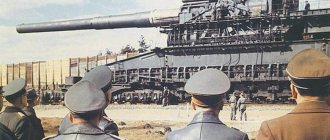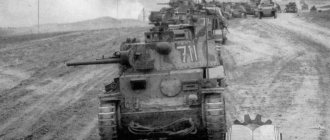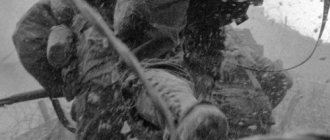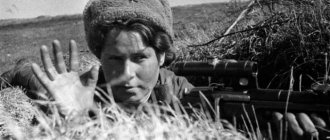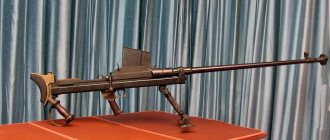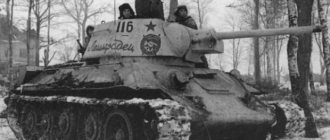Mikhail Surkov
The most successful of the Soviet snipers is the foreman of the 4th Infantry Division of the 12th Army, Mikhail Ilyich Surkov. Before the war, like many of our snipers, he was a hunter. He lived in the village of Bolshaya Salyr, now Achinsky District, Krasnoyarsk Territory.
He has 702 killed fascists. Such a huge figure is difficult to believe, and it has been questioned more than once. However, all target defeats were documented; this was required by strict rules in the Red Army.
He went to the front in the fall of 1941. After the seventh wound, in 1943 he was discharged from the active army. He was nominated for the title of Hero of the Soviet Union, but he never received it. Returning to his homeland, he was elected chairman of the village council. However, his health was undermined during the war, and Mikhail Ilyich died early, at the age of 32.
Lay in the cold for hours
Arriving at the front, Surkov, as an excellent shooter, immediately asked to be assigned as a sniper, and by March 7, 1942, the Siberian had already killed more than a hundred Nazis on his personal account. Soon, at a gathering of front-line snipers, where the achievements of individual Red Army soldiers in eliminating enemy soldiers were discussed, Mikhail spoke about his ambush near the village of Troitskoye. “We came with a partner in the dark, made a “nest”, lay down in it and were well camouflaged. Shortly after sunrise we saw one of the Germans come out of the trench, stretch and look to the east. I put him at gunpoint and, holding my breath, pulled the trigger. The Hitlerite fell on his back as if knocked down. And two or three minutes later another one jumped out of the trench. Leaning over the man lying, he apparently wanted to help him or find out what had happened. I shot again. The second fascist fell on the dead man and crushed him with his body.” Trying to watch for that same couple of Germans, Mikhail lay motionless for several hours deep in the snow in the bitter cold - minus fifteen degrees. He told his colleagues: “We are used to this in Siberia, it’s still warm.”
The booty of sniper Nomokonov. How a taiga hunter became a Nazi nightmare Read more
Vasily Zaitsev
Hero of the Soviet Union, he became legendary during his lifetime. In just a month and a half of the battle, the sweat of Stalingrad eliminated 225 German soldiers and officers. Of these, eleven people were the same snipers as Zaitsev himself. But everyone was shot by a Soviet professional.
Vasily Grigorievich Zaitsev was born in 1915, in the village of Elenkina, Orenburg province (now in the Chelyabinsk region). As a child, I learned to shoot a hunting rifle, given by my grandfather for his twelfth birthday.
After the start of the Great Patriotic War, in the summer of 1942, Zaitsev enlisted in the 284th Infantry Division. In September of the same year he took part in the Battle of Stalingrad.
For his exploits in the sniper field, he was awarded the medal “For Courage” and a sniper rifle. He became famous on all fronts. The award rifle is now on display in the Volgograd Panorama Museum “Battle of Stalingrad”. After the victory, the weapon was engraved with “Hero of the Soviet Union, Guard Captain Vasily Zaitsev. He buried more than 300 fascists in Stalingrad.”
After the war, Vasily Grigorievich worked in Kyiv as the director of the “Ukraine” garment factory, then headed the technical school. The former sniper was a marksman until a very old age. Once he was invited to evaluate the training of young snipers and show them his art. As a result, the cup for the best shooting was awarded not to the young masters, but to the veteran Zaitsev.
The outstanding shooter died in 1991. Initially he was buried in Kyiv, but in 2006 his will was executed. The sniper was buried on the heroic soil of Stalingrad, which he selflessly defended.
In 1973, writer William Craig immortalized Zaitsev's exploits in the book Enemy at the Gates. And in 2001, a film was made in Hollywood based on this literary work. There are two more Russian films about Vasily Zaitsev - the fictional “Angel of Death”, 2002, and the documentary “Legendary Sniper”, 2013.
Propaganda played its role
The best snipers of the Second World War, namely their achievements, were actively used in propaganda. Quite often it happened that the personalities of the shooters began to acquire legends.
The famous domestic sniper Vasily Zaitsev was able to destroy about 240 enemy soldiers. This figure was average for effective marksmen of that war. But due to propaganda, he was made the most famous Red Army sniper. At the present stage, historians seriously doubt the existence of Major Koenig, Zaitsev’s main opponent in Stalingrad. The main achievements of the domestic shooter include the development of a sniper training program. He personally took part in their preparation. In addition, he formed a full-fledged sniper school. Its graduates were called “hares.”
Lyudmila Pavlichenko
The USSR became the only country on earth in which not only men knew sniper science - women fought just as skillfully.
The most effective of them was Lyudmila Pavlichenko, who shot 309 enemy soldiers and officers. She served as a sniper in the 25th Chapaev Rifle Division. In 1943 she received the title of Hero of the Soviet Union.
At the end of hostilities, she became an employee of the General Staff of the Navy of the Soviet Union, with the rank of major in the coast guard.
At the initiative of journalists from the United States, she was given the nickname “Lady Death.” But this expression was used only by the Western press. After all, in the Soviet country, people did not perceive the bright image of the defender of the state as a murderer leaving behind mountains of corpses. On the contrary, her heroic dedication, her exploits were for Soviet citizens the standard of heroism and love for the Fatherland.
There is little information about enemy shooters
There is not so much data about “colleagues” on the enemy side. This is due to the fact that no one tried to boast of their exploits. Therefore, the best German snipers of the Second World War are practically unknown in ranks and names. One can only say with certainty about those shooters who were awarded the Knight's Iron Cross. This happened in 1945. One of them was Frederick Payne. He killed about 200 enemy soldiers. The most productive player was probably Matthias Hetzenauer. They killed about 345 soldiers. The third sniper who was awarded the order was Joseph Ollerberg. He left memoirs in which quite a lot was written about the activities of German riflemen during the war. The sniper himself killed about 257 soldiers.
Vladimir Salbiev
Vladimir Gavrilovich Salbiev served in the 95th Guards Rifle Division and killed 601 Wehrmacht soldiers and officers. It follows from the award sheet that the shooter undertook to eliminate 45 fascists by the Day of the Great October Revolution. He fulfilled and exceeded his plan.
By 1943, he already had 85 killed opponents. In 1943, the sniper was nominated for the title of Hero of the Soviet Union, but in the end he was awarded another Order of the Red Banner. Returning from the war, he continued his career and worked in the criminal investigation department.
Hunters turned soldiers
Before the First World War, the most famous marksmen were those whose accurate shot hit a famous enemy, even if it was purely by chance. Thus, the American TV channel Military Channel listed Daniel Morgan as one of the top 10 best snipers from the American War of Independence. At the Battle of Saratoga, he shot and killed British General Simon Fraser from 500 yards (about 450 meters) (according to other sources, the success was achieved by sniper Timothy Murphy, who served in the regiment under Morgan's command). The death of the general became one of the turning points in the battle, considered the turning point of the entire war. British Major Patrick Fergusson, on the contrary, became famous for not firing a shot that could change the course of history: he allegedly, without knowing it, held George Washington at gunpoint, but did not pull the trigger - the officer at whom Fergusson was aiming turned his back, and the Englishman considered such a shot ungentlemanly.
The first experience of the mass use of snipers in combat is considered to be the Anglo-Boer War of 1899-1902. Among the Boer militia there were many experienced hunters who terrified the British soldiers with their guns. They even had a rule - “three people don’t light a cigarette with one match: the first one lit it - the drill noticed, the second lit it - the drill took aim, the third lit it - the drill fired.”
Francis Peghmagabow
Photo: Fox Meadow Creations
Full-time sniper units appeared during the First World War, first among the Germans, and then in the armies of the Entente. It is with the First World War that the number of victories is considered the criterion of sniper skill. The record holder of those times is the Canadian Indian hunter Francis Peghmagabow, who killed 378 enemies.
Moreover, successful snipers have turned into an effective propaganda tool, so the difference in the assessment of killed opponents sometimes reaches several hundred. It is worth noting that the snipers’ victories were recorded from their words and the words of their comrades, and most of the victims remained on enemy territory.
In our ranking, we used indicators such as personal score, unique achievements (for example, the longest shot), as well as fame and frequency of mentions in Russian and foreign sources.
Maxim Passar
Ethnic Nana, sniper Maxim Aleksandrovich Passar eliminated 236 Nazis. He served in the 71st Guards Rifle Division. Unfortunately, the hero died on January 17, 1943 during a battle near the village of Peschanka, Gorodishchensky district.
Having not received the title of Hero of the Soviet Union during his lifetime, on February 16, 2010, by Decree of the President of Russia No. 199, he was posthumously awarded the title of Hero of the Russian Federation.
Josef Alleberger
Born in Austria. Became the second most successful among German snipers. Josef Allerberger killed 257 opponents. At first he served as a machine gunner, later he became a rifleman in the 3rd Mountain Rifle Division.
He had been in the army since July 1943. At the end of the war he fought in Czechoslovakia, not far from the Austrian border. The German Ministry of Propaganda under the leadership of Goebbels made the sniper famous. As a result, his photos were reprinted many times in the fascist press.
However, fame only harmed the soldier. He thought that he could not live in Soviet captivity, so he tried by any means to get home. The shooter wandered in the Alpine forests for two weeks, and only after the official end of hostilities was he able to return to Austria. After the war, Joseph worked as a carpenter, following in his father's footsteps, and died in the city of Wals-Siezenheim, Austria.
Only time has changed the attitude towards female shooters
The girls, the best snipers of World War II, whose photos can be seen in this review, experienced terrible things in their time. And when they returned home, they sometimes encountered contempt. Unfortunately, in the rear, a special attitude was formed towards girls. Many unfairly called them field wives. This is where the contemptuous looks that female snipers received came from.
For a long time they did not tell anyone that they were at war. They hid their rewards. And only after 20 years did attitudes towards them begin to change. And it was at this time that the girls began to open up, talking about their many exploits.
Gefreiter Matthias Hetzenauer
Matthias Hetzenauer became the best sniper of the Wehrmacht - 345 killed opponents to his credit. In Nazi Germany, his successes in combat were called “phenomenal results of sniper warfare.” And this seemed to be true, since the sniper achieved such a result in just less than a year of participation in the war.
He served in the 3rd Mountain Division, in the same regiment with Joseph Allerberger. In 1944 he completed sniper training courses, and from the summer of that year he was at the front. The shooter took part in battles in Hungary and Slovakia, including in the Carpathian Mountains.
In service he used a Mauser 98k rifle with a 6x optical sight, and also used a Gewehr 43 semi-automatic rifle with a 4x scope. At the very end of the war, Matthias was captured by the Red Army and was kept in GUPVI camps for 5 years. In 1950 he was released and returned to Germany. He died in October 2004 after a long illness.
The emergence of sniper art
Since the emergence of personal weapons in armies, which provided the opportunity to hit the enemy at long distances, accurate shooters began to be distinguished from soldiers. Subsequently, separate units of rangers began to form from them. As a result, a separate type of light infantry was formed. The main tasks that the soldiers received included the destruction of officers of enemy troops, as well as the demoralization of the enemy through accurate shooting at significant distances. For this purpose, shooters were armed with special rifles.
In the 19th century, modernization of weapons occurred. The tactics changed accordingly. This was facilitated by the emergence of an optical sight. During the First World War, snipers were part of a separate cohort of saboteurs. Their goal was to quickly and effectively defeat enemy personnel. At the very beginning of the war, snipers were mainly used by the Germans. However, over time, special schools began to appear in other countries. In conditions of protracted conflicts, this “profession” has become quite in demand.




